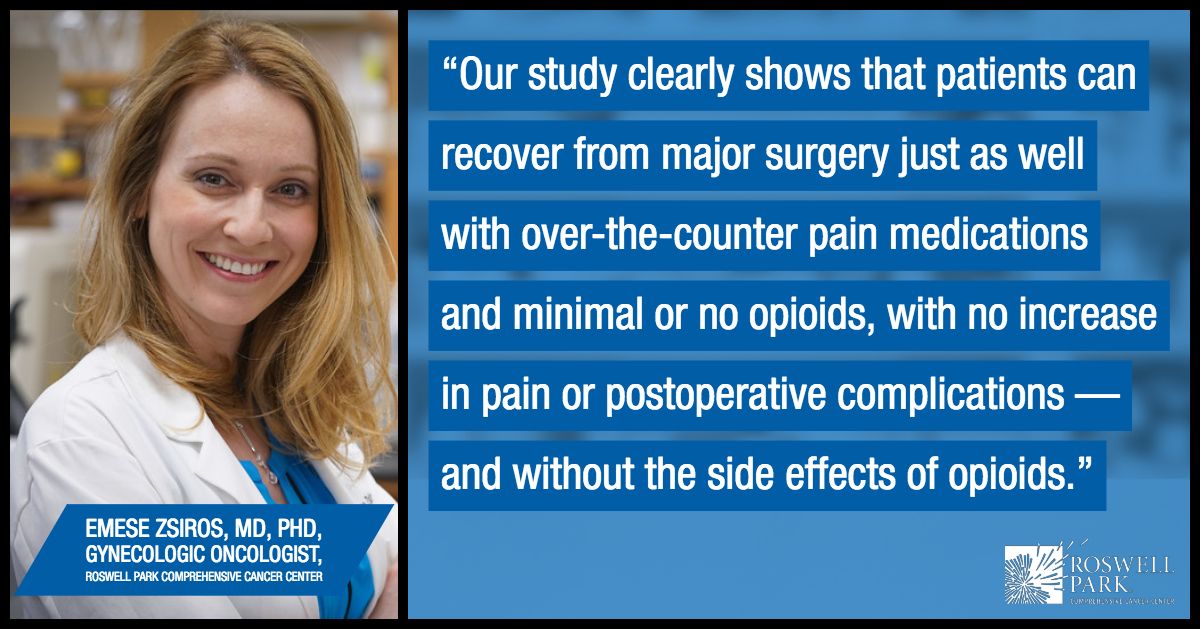Striking Roswell Park research leads to new care guidelines to combat opioid crisis
- Number of prescribed opioids dramatically reduced, without detrimental effect
- Two-year study finds postsurgical pain can be managed with few or no opioids
- Opioid-sparing approach will guide care of Roswell Park surgical patients Jan. 1
BUFFALO, N.Y. — Pain after surgery can be effectively managed with minimal or no opioids, according to research conducted at Roswell Park Comprehensive Cancer Center and published today in JAMA Network Open. A two-year study by a multidisciplinary team of surgeons and other cancer specialists found that the amount of opioid medications prescribed after surgery can be drastically reduced without negatively affecting pain scores, postoperative complications or patient requests for additional opioids, demonstrating that alternative approaches to pain management can be both safe and highly effective.
The publication presents the findings of a two-year pilot study at Roswell Park in which patients undergoing gynecologic or abdominal surgery were prescribed fewer opioids at discharge.
The impact of the pilot was striking. During its first year alone, the restrictive protocol eliminated the circulation of 16,374 opioid tablets (5 mg oxycodone equivalent), significantly reducing the volume of opioids that could be misused or diverted. The results of the full two-year study in 1,231 patients demonstrate that because postoperative pain can be managed effectively without opioids for minor or minimally invasive surgical procedures or with only a three-day supply for major surgery, the risks of chronic opioid misuse can be managed by reducing or eliminating opioid prescriptions in the first place.
Based on the success of the opioid-sparing approach to postsurgical pain management, the new restrictive protocol will go into effect as a care guideline throughout all Roswell Park surgical services beginning January 1, 2019. Roswell Park is believed to be the first cancer center in the U.S. to implement such radical opioid-sparing guidelines so broadly. This change in practice — which will impact care for surgical patients only and will not affect pain management for those with cancer-related or chronic pain — is expected to reduce health care costs while protecting patients and the greater community from the risks associated with opioid use.
Background
Opioids are a group of drugs that include prescription pain relievers such as hydrocodone (Vicodin, Norco) and oxycodone (OxyContin, Percocet), as well as morphine and heroin. Millions of Americans are routinely prescribed opioids for acute pain following surgery despite the serious risks associated with opioid use, such as addiction, overdose and death. Opioid misuse has become a major health and economic issue in the U.S., claiming more than 100 lives per day. Nearly 5 million people misuse prescription pain relievers each year, and 80% of heroin users report that their addiction started with a prescription opioid painkiller.
In 2016, to combat the opioid crisis, New York State began limiting opioid prescriptions to a seven-day supply for acute pain. However, pain associated with cancer treatment is exempt from this rule, leaving the decision to the treating physicians, who currently have no clear guidelines on the amount of opioid pain medications needed after cancer-related surgery.
“Nearly all of my patients would call to ask what to do with their leftover pain pills,” says Emese Zsiros, MD, PhD, FACOG, Assistant Professor of Oncology with Roswell Park’s Department of Gynecologic Oncology and Center for Immunotherapy and senior author of the new study. “I didn’t have a clear answer for them, as these medications are difficult to dispose of, and you don’t want them sitting in an unlocked medicine cabinet, where family members or friends can easily access them.”
Based on patient feedback and her own clinical experience, Dr. Zsiros hypothesized that she was most likely overprescribing opioid pain medication to her patients, particularly those undergoing minor laparoscopic and robotic surgeries, thereby increasing the risk of opioid use, abuse and diversion not only among her patients but also the community at large. “I knew that postoperative acute pain can be effectively managed without opioids from what I observed during my training in Europe,” Dr. Zsiros adds.
Implementing a New Approach
She convinced her team to drastically reduce or eliminate opioid prescriptions for patients following gynecologic surgery from a seven-day supply to a three-day supply or none, based on the type of surgery. Beginning in June 2017, patients undergoing ambulatory or minimally invasive surgery were not prescribed opioids at the time of hospital discharge unless they required more than five doses of opioids while in the hospital. Patients undergoing major surgery (laparotomy) were given only a three-day supply of prescription opioids (12 pills) at discharge, unless they needed more opioids during the last 24 hours of their hospital stay, in which case they were given 24 pills. All patients were prescribed a pain regimen of 600 mg ibuprofen (Advil or Motrin) and 500 mg acetaminophen (Tylenol) every 6 hours as needed for seven days. Before undergoing surgery, all patients were educated about the revised protocol, including what to expect in terms of pain or possible complications, the adverse effects of opioid pain medications, and alternative methods of pain control. Patients were also encouraged to contact their clinical team with any questions or concerns, particularly if their pain was not adequately managed, and staff were educated about how to introduce this new protocol to their patients.
The new ultrarestrictive opioid prescription protocol (UROPP) was a major change in clinical practice for these patients. Before the restrictive protocol was implemented, the average patient received 44 opioid pills after major open surgery, 38 pills after minimally invasive (robotic or laparoscopic) surgery and 14 pills after minor surgery, an approach that is typical of most U.S. cancer centers. The new protocol radically decreased this amount to an average of 12 tablets after major surgery, one tablet after minimally invasive surgery, and essentially none after minor or ambulatory surgery.
Study Results
During the first two weeks of the new protocol, not a single patient complained of pain or requested an opioid prescription refill. The number of patients who eventually requested opioid refills within 30 days of surgery during the first year of the new protocol — 16% — was no different from the year prior to the opioid restrictions, when 16.5% of patients requested refills.
“We were quite surprised by how few requests for medication we got from our patients,” says Jaron Mark, MD, Clinical Fellow at Roswell Park and the first author of the study. “We expected we would be able to reduce the use of opioids without detrimental consequences, but the extent to which our hypothesis was supported by these results was really striking.” He added that proper patient education before surgery helped manage each patient’s expectations about what to expect after surgery in terms of pain and recovery, which helped to ensure good patient compliance with the protocol after discharge.
The new protocol appeared to be highly effective, and after a full year, Dr. Zsiros and her team did a prospective analysis to compare pain management and surgical recovery in the 605 patients treated from June 2017 through June 2018 on the restrictive opioid prescription protocol to a control group of 626 patients treated during the previous year, before the new protocol was implemented. Particular attention was paid to opioid use, pain scores, and complications in the 30 days before and after surgery, and ISTOP, New York State’s opioid prescription tracking system, was used to confirm that patients did not receive opioid prescriptions elsewhere (such as a primary care physician or emergency room) during this 60-day period.
The researchers found that the two groups of patients were similar in terms of age, race, diagnosis and type of surgery performed. Both groups had similarly low rates of complications during and after surgery. Although these two groups received vastly different amounts of opioids after surgery, pain scores at time of discharge and two weeks after surgery were also low and nearly identical in both groups, as were the number of patients requesting opioid prescription refills, despite the drastic difference in the amount of opioids prescribed between groups.
Regardless of the amount of opioids prescribed, 84% of patients in both groups did not request additional pain medication, showing that patients can recover just as well after surgery with few or no opioids. This finding also suggests that these refill requests may not be pain related and that some patients use opioid medication as a way of coping with the stress, anxiety and emotional discomfort that accompany surgery or a health crisis, such as cancer.
“Physicians are often concerned that reducing or eliminating opioid prescriptions will be very challenging, especially for patients who are accustomed to managing pain with opioids,” adds Dr. Zsiros. “However, our study clearly shows that patients can recover from major surgery just as well with over-the-counter pain medications such as ibuprofen or acetaminophen and minimal or no opioids, with no increase in pain or postoperative complications — and without the side effects of opioids, such as nausea, constipation, sluggishness and dizziness, as well as the risk of long-term opioid use, abuse and diversion. About one in every 20 patients prescribed opioid medication for acute pain will become chronic users, so in my opinion, opioid addiction can be viewed as a significant postoperative complication that clinical teams must work to prevent.”
The study, “Ultrarestrictive Opioid Protocol for Pain Management After Gynecologic and Abdominal Surgery,” was supported by grants from the National Cancer Institute (project nos. P30CA016056 and T32CA108456). The published article is available at http://jamanetwork.com/journals/jamanetworkopen/fullarticle/10.1001/jamanetworkopen.2018.5452.
###
Editor’s note: A Roswell Park patient-education video explaining this approach and addressing anticipated questions is available for use by clinical care teams on YouTube.
About Roswell Park
Roswell Park Comprehensive Cancer Center is a community united by the drive to eliminate cancer’s grip on humanity by unlocking its secrets through personalized approaches and unleashing the healing power of hope. Founded by Dr. Roswell Park in 1898, it is the only National Cancer Institute-designated comprehensive cancer center in Upstate New York. Learn more at www.roswellpark.org, or contact us at 1-800-ROSWELL (1-800-767-9355) or ASKRoswell@RoswellPark.org.
Annie Deck-Miller, Senior Media Relations Manager
716-845-8593; annie.deck-miller@roswellpark.org

